论文大纲-英语电影片名的翻译
- 格式:doc
- 大小:37.50 KB
- 文档页数:2
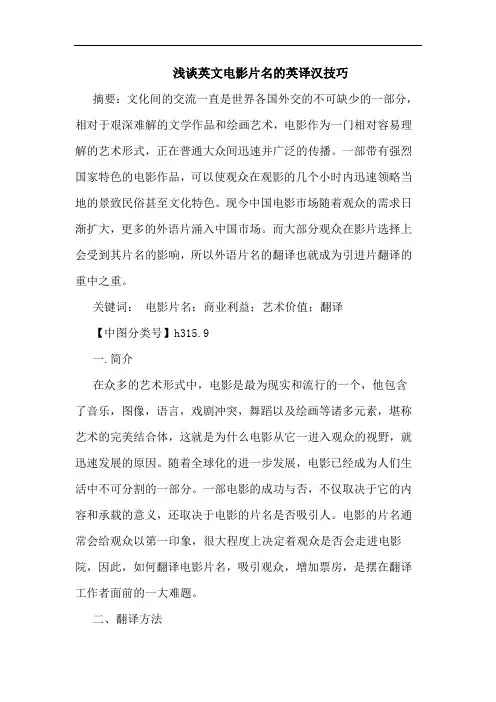
浅谈英文电影片名的英译汉技巧摘要:文化间的交流一直是世界各国外交的不可缺少的一部分,相对于艰深难解的文学作品和绘画艺术,电影作为一门相对容易理解的艺术形式,正在普通大众间迅速并广泛的传播。
一部带有强烈国家特色的电影作品,可以使观众在观影的几个小时内迅速领略当地的景致民俗甚至文化特色。
现今中国电影市场随着观众的需求日渐扩大,更多的外语片涌入中国市场。
而大部分观众在影片选择上会受到其片名的影响,所以外语片名的翻译也就成为引进片翻译的重中之重。
关键词:电影片名;商业利益;艺术价值;翻译【中图分类号】h315.9一.简介在众多的艺术形式中,电影是最为现实和流行的一个,他包含了音乐,图像,语言,戏剧冲突,舞蹈以及绘画等诸多元素,堪称艺术的完美结合体,这就是为什么电影从它一进入观众的视野,就迅速发展的原因。
随着全球化的进一步发展,电影已经成为人们生活中不可分割的一部分。
一部电影的成功与否,不仅取决于它的内容和承载的意义,还取决于电影的片名是否吸引人。
电影的片名通常会给观众以第一印象,很大程度上决定着观众是否会走进电影院,因此,如何翻译电影片名,吸引观众,增加票房,是摆在翻译工作者面前的一大难题。
二、翻译方法针对电影片名的特点,我们在翻译片名时,一般应采用如下四种方法2.1音译法所谓音译法,就是按源语的发音规则。
直接翻译成目的语发音相同或类似的文字语言。
这是电影片名最简单、最方便的翻译方法。
也是最常用的方法之一。
在英美影片中,常用主人公的名字或故事发生的地点作为片名,其中有些是由著名的文学作品改编而成的,其人名、地名早已为众多的民族所熟悉(冯晓霞,2005),所以翻译时可直接采用音译法。
例如: titanic-《泰坦尼克号》 jane eyre-《简爱》。
2.2直译(literal translation)。
对于影片名的翻译而言,直译也可称为全译,指在语言共性的基础上,在合乎译文的全民规范的情况下,也就是在译文语言条件许可时,既保持原文的思想内容,又尽可能保持与原文语言形式相对应的形式(如比喻、形象和民族地方色彩等)的翻译。
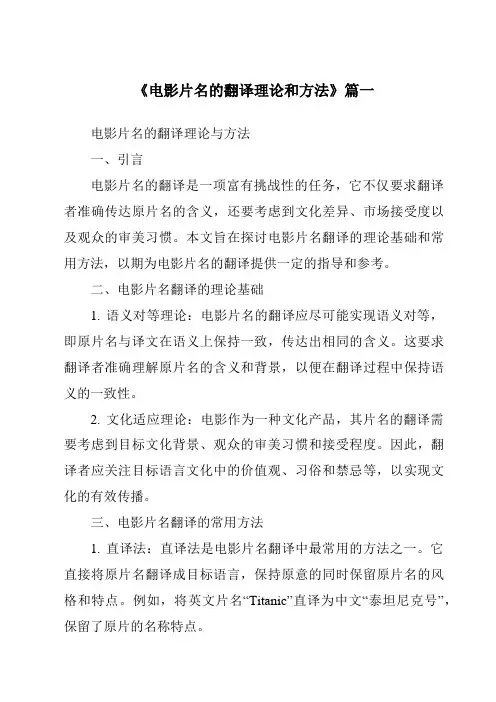
《电影片名的翻译理论和方法》篇一电影片名的翻译理论与方法一、引言电影片名的翻译是一项富有挑战性的任务,它不仅要求翻译者准确传达原片名的含义,还要考虑到文化差异、市场接受度以及观众的审美习惯。
本文旨在探讨电影片名翻译的理论基础和常用方法,以期为电影片名的翻译提供一定的指导和参考。
二、电影片名翻译的理论基础1. 语义对等理论:电影片名的翻译应尽可能实现语义对等,即原片名与译文在语义上保持一致,传达出相同的含义。
这要求翻译者准确理解原片名的含义和背景,以便在翻译过程中保持语义的一致性。
2. 文化适应理论:电影作为一种文化产品,其片名的翻译需要考虑到目标文化背景、观众的审美习惯和接受程度。
因此,翻译者应关注目标语言文化中的价值观、习俗和禁忌等,以实现文化的有效传播。
三、电影片名翻译的常用方法1. 直译法:直译法是电影片名翻译中最常用的方法之一。
它直接将原片名翻译成目标语言,保持原意的同时保留原片名的风格和特点。
例如,将英文片名“Titanic”直译为中文“泰坦尼克号”,保留了原片的名称特点。
2. 意译法:意译法是根据原片名的含义,用目标语言重新表达,使译文更符合目标语言的表达习惯。
例如,将英文片名“Interstellar”意译为中文“星际穿越”,使观众更容易理解影片的题材和内容。
3. 创意译法:创意译法是通过对原片名进行重新构思和组合,创造出一个新颖的译文。
这种方法要求翻译者具备一定的创新思维和想象力,以便为观众呈现出一个富有创意的片名。
例如,“Amadeus”被译为“莫扎特传”,在保持原意的同时也具有一定的创意性。
四、电影片名翻译的注意事项1. 准确理解原片名的含义:翻译者需要准确理解原片名的含义和背景,确保译文与原片名在语义上保持一致。
2. 考虑文化差异:在翻译过程中,应关注目标语言文化中的价值观、习俗和禁忌等,以实现文化的有效传播。
3. 保持简洁明了:电影片名的翻译应简洁明了,使观众能够迅速了解影片的主题和内容。
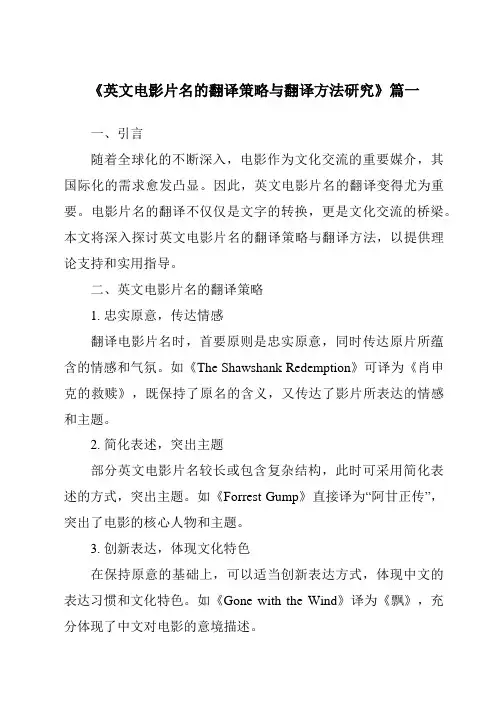
《英文电影片名的翻译策略与翻译方法研究》篇一一、引言随着全球化的不断深入,电影作为文化交流的重要媒介,其国际化的需求愈发凸显。
因此,英文电影片名的翻译变得尤为重要。
电影片名的翻译不仅仅是文字的转换,更是文化交流的桥梁。
本文将深入探讨英文电影片名的翻译策略与翻译方法,以提供理论支持和实用指导。
二、英文电影片名的翻译策略1. 忠实原意,传达情感翻译电影片名时,首要原则是忠实原意,同时传达原片所蕴含的情感和气氛。
如《The Shawshank Redemption》可译为《肖申克的救赎》,既保持了原名的含义,又传达了影片所表达的情感和主题。
2. 简化表述,突出主题部分英文电影片名较长或包含复杂结构,此时可采用简化表述的方式,突出主题。
如《Forrest Gump》直接译为“阿甘正传”,突出了电影的核心人物和主题。
3. 创新表达,体现文化特色在保持原意的基础上,可以适当创新表达方式,体现中文的表达习惯和文化特色。
如《Gone with the Wind》译为《飘》,充分体现了中文对电影的意境描述。
三、英文电影片名的翻译方法1. 直译法直译法是最常用的翻译方法之一。
对于一些简单明了、意义明确的英文电影片名,可采用直译法进行翻译。
如《Titanic》可直译为《泰坦尼克号》。
2. 意译法对于一些抽象、寓意深远的英文电影片名,可采用意译法进行翻译。
在保持原意的基础上,通过创新的表达方式传达电影的主题和情感。
如《The Pianist》可译为《钢琴家》,突出了影片的文艺氛围和人物特点。
3. 音译法对于一些特殊类型或国际知名的英文电影片名,可采取音译法进行翻译。
如《Matrix》可音译为“魔戒”,凸显其独特的国际知名度。
四、结论综上所述,英文电影片名的翻译策略与翻译方法具有多样性和复杂性。
在翻译过程中,应遵循忠实原意、传达情感的原则,同时根据具体情况选择合适的翻译方法和策略。
此外,还需关注文化差异和表达习惯的差异,力求在保持原意的基础上实现创新的表达方式。
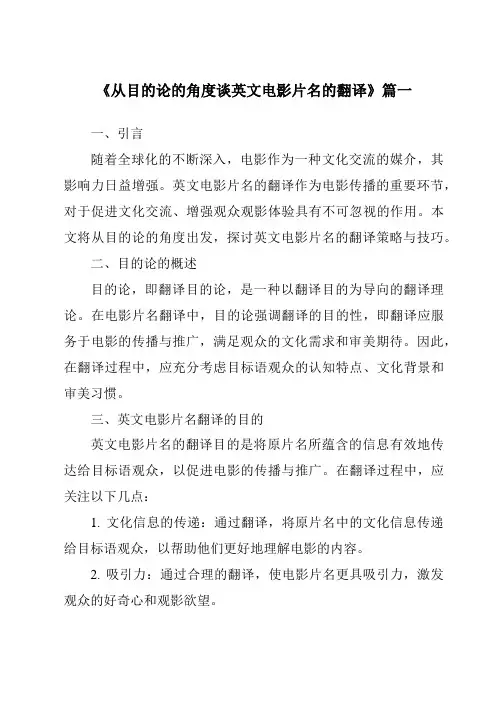
《从目的论的角度谈英文电影片名的翻译》篇一一、引言随着全球化的不断深入,电影作为一种文化交流的媒介,其影响力日益增强。
英文电影片名的翻译作为电影传播的重要环节,对于促进文化交流、增强观众观影体验具有不可忽视的作用。
本文将从目的论的角度出发,探讨英文电影片名的翻译策略与技巧。
二、目的论的概述目的论,即翻译目的论,是一种以翻译目的为导向的翻译理论。
在电影片名翻译中,目的论强调翻译的目的性,即翻译应服务于电影的传播与推广,满足观众的文化需求和审美期待。
因此,在翻译过程中,应充分考虑目标语观众的认知特点、文化背景和审美习惯。
三、英文电影片名翻译的目的英文电影片名的翻译目的是将原片名所蕴含的信息有效地传达给目标语观众,以促进电影的传播与推广。
在翻译过程中,应关注以下几点:1. 文化信息的传递:通过翻译,将原片名中的文化信息传递给目标语观众,以帮助他们更好地理解电影的内容。
2. 吸引力:通过合理的翻译,使电影片名更具吸引力,激发观众的好奇心和观影欲望。
3. 准确性:确保翻译的准确性,避免因误解原片名而导致的观众对电影内容的误解。
四、英文电影片名翻译的策略与技巧根据目的论的指导,英文电影片名的翻译应采用以下策略与技巧:1. 直译与意译相结合:在保证准确传达原片名信息的基础上,根据目标语观众的文化背景和审美习惯,灵活运用直译和意译的翻译方法。
例如,将《The Shawshank Redemption》(肖申克的救赎)译为“希望之光”,既保留了原片名的精髓,又使目标语观众更容易理解。
2. 简化与增补:对于一些过长或信息冗余的英文片名,可采用简化与增补的翻译方法。
简化是指将原片名中的冗余信息省略,只保留核心内容;增补则是在原片名的基础上添加相关信息,以帮助目标语观众更好地理解电影内容。
例如,《Jurassic Park》(侏罗纪公园)通过增补“恐龙”这一关键词,使目标语观众更易理解电影的主题。
3. 创新与再创造:在遵循翻译原则的基础上,可对原片名进行适当的创新与再创造。
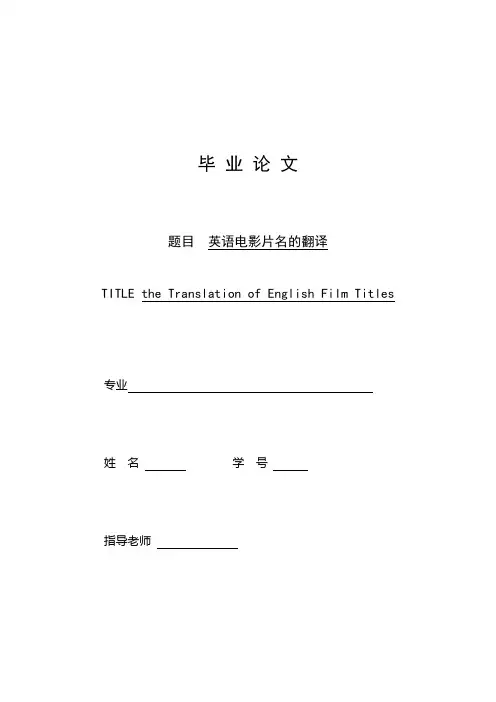
毕业论文题目英语电影片名的翻译TITLE the Translation of English Film Titles 专业姓名学号指导老师中文摘要经过一个多世纪的发展,电影如今已经成为了一种常见的娱乐方式。
而随着全球化的发展,人们有了更多的机会来欣赏制作精良、精彩纷呈的外国电影。
为了使中国观众明白整部电影的内容,就需要将电影翻译成中文,这其中就包括了电影片名的翻译。
作为影片不可或缺的一部分,电影片名有其独特的语言特色和民族文化内涵,是电影艺术性和票房商业性的集中体现。
电影片名翻译属于实用英语翻译的范畴。
一部电影片名的功能就是要吸引观众走进影院去观赏这部电影,这也同样是翻译电影片名的目的。
本文以起源于德国的功能派翻译理论为基础,对电影片名翻译的现象作出了解释,并分析了在目的论指导下,音译、直译、意译及改译几种翻译策略在英语电影片名汉译中的应用。
关健词: 电影片名翻译,功能翻译,目的论,翻译策略IAbstractHaving developed for over a century, film has become one of the most popular ways of entertainment for people. People have much more chances to appreciate the elaborate and excell ent films. In order to enable the Chinese audience to understand the film's content, thewhole film should be translated, including its title. As an indispensable part of a film, the title has its unique linguistic feature and culture connotation.Film title translation belongs to general English-Chinese translation. Its function is to push the audience to go to the cinema after seeing the title, which is also the skopos of film title translation.In this thesis, the author makes an analysis of the film title translation from the functional perspective. And the application of translation strategies, namely, transliteration, literal translation, liberal translation and adaption, is also analyzed with rich examples under the guidance of the functionalist approach.Keywords: film title translation; functionalist approach; Skopos theory; translation strategiesII中文文摘电影是一种集艺术性和商业性于一体的艺术形式,是最具有影响力的媒体之一。
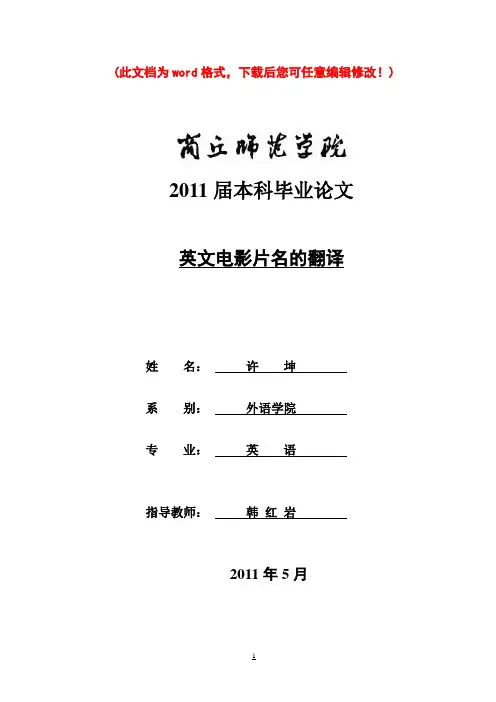
(此文档为word格式,下载后您可任意编辑修改!)2011届本科毕业论文英文电影片名的翻译*名:**系别:外语学院专业:英语指导教师:***2011年5月Translation of the English Movie TitlebyXu KunShangqiu Normal UniversityMay 2011摘要电影,是当今社会最具影响力的文化传播形式之一。
电影片名的翻译是电影翻译中的重要部分。
电影片名的翻译必定是一项重要而富于创造性的工作。
中文电影片名的成功翻译对推动中国电影走向世界,促进中西文化艺术交流都会起到不可忽视的作用。
本文通过分析大量英文电影的汉语译名,提出了在电影片名翻译中应该遵循的三个原则,并总结了六种翻译方法。
并以实例从人文文化、宗教文化、生活环境、历史典故等几方面来阐述文化差异在翻译片名中的翻译方法、翻译效果的影响以及翻译中应注意的事项。
本文共分四部分,分别从电影片名翻译的概述和现状、翻译应遵循的原则、还有翻译的方法以及翻译与文化的关系予以阐述。
因此,英文电影片名的翻译是一项重要而富有创造性的工作,要遵循一定的原则和翻译的方法并使之符合汉语语言特征,达到文字的优美生动传情。
关键词: 英文电影;片名;翻译;原则;方法AbstractMovie is the most influential contemporary forms of cultural transmission. Movie titles translation is an important part of the movie, and must be an important and creative work. Chinese movie titles translation in promoting the success of Chinese movies to the world, and promote the exchange of Chinese and Western culture plays a significant role. By analyzing a large number of movie titles translation, we should follow the three principles, and summarizes the six translation method while translation. Further more, the example from the culture, religion and culture, living environment, be best to elaborate the process of translation, the effect of translation and the translation notices.This article is divided into four parts, namely, translation of movie titles from theoverview of the status of translation, translation principles to be followed, as well as methods of translation and the relationship between translation and culture to be described. Therefore, the English translation of movie titles is an important and creative work, to follow certain principles and methods of translation and make it consistent with characteristics of Chinese language, to become the beautiful vivid teaser text.Key words: English movies; title; translation; principle; methodContents摘要 (I)Abstract (II)Contents (III)1Introduction (1)2Techniques of English Movie Title Translation (2)2.1Translation Principle (2)2.1.1Information Principle (3)2.1.2Culture Principle (3)2.1.3Aesthetic Principle (4)2.2Translation Method (5)2.2.1Literal Translation (5)2.2.2Transliteration (6)2.2.3Liberal Translation (6)2.2.4Other Methods (7)3Culture Differences and Movie Title Translation (9)3.1Humanities (9)3.2Religious Culture (9)3.3Living Environment (10)3.4Historical Allusions (10)4Conclusion (11)References (11)1IntroductionMovie can convey information and feelings, is a popular form of artistic expression. However, movie is different from other categories of works of the art, it does not like books, newspapers listed on file to attract the audience, so the movie’s title of a movie plays an important role in its success. With the continuous development of the world economy, since the reform and opening up policy, China movies, more and more English movies dubbed into China’s cinema, television, and networks; the same thing as raising the level of Chinese movie, there are more and more Chinese movies are go abroad to attract the world’s peoples attention and began to impact the world awards. This means that more and more Chinese, foreigners will use the movie as a propaganda tool to know the western culture, Chinese culture, and culture exchange. In the course of this particular culture exchange movie translation is a very important role to play, and the translation of movie titles is one of the unique and critical things to attract audience’s attention. Many foreign movies, especially British and American movies widely circulated in China, , to further promote the movie industry development and promote cultural exchange are significant important.So of the movie titles, the brief summary of the text should not only to express the movie themes, but also to meet the target countries and cultural background to attract audience and cultural exchange purposes. Therefore, the translation of the movie titles is not a pure, simple language conversion work, it need the translator know the movie itself, the implication of the culture background, and cultural background between the two languages. There are details are as follow.However, in recent years, the movie title translation was not perfect, the present situation of movie title translation mainly reflect as follow. First, inadequate understanding the story, the title for the movie, do not rush to translate, to understand the contents of the entire movie, story, and the story content, so as to make an accurate translation. Second, misunderstanding the culture information,movie title usually not make accurate translation.Movie titles are always the first thing that the audiences come to know about new movies. Thus a right choice of movie title translation is of great importance to the successful release of a movie. A properly-translated English movie title should fulfill the following functions:First: Providing information about the story for the audience by summarizing the main plot, revealing the theme, or offering some clue.Second: Adding attraction to the mov ie and stimulating the audience’s interest in and desire for viewing the movie.Third: Saving trouble for the cinema, the audience, movie reviewers and other research workers in their publicity, choice of viewing, comments and studies.2Techniques of English Movie Title TranslationTechniques of English movie title translation mainly fall into two categories: showing respect for the original title and discarding the original one “No matter what technique is employed, one fundamental and vital principle that should never be forgotten is that the translation must be related to the story in one way or another.”(Eugene A, 2001, p.214).2.1Translation PrincipleThe translation makes the audience feel the movies deep flavor, while some people think the movie is incomprehensible translation. This shows that the translation of the movie titles need to meet certain principles.Translation of the movie titles, as Bauhinia point out, “it is necessary to meet the language specification and artistic charm, not only to be faithful to the original title of the content, but also reflect the original name of the language features, striving toachieve the artistic re-creation.”2.1.1Information PrincipleThe primary function of language is to transmit information. The information should not only accuracy in meaning but also faithful to the original material.American movie One Flew over the Cuckoo’s Nest Taiwan is translated as dujuanwo people feel very confused. In fact the whole movie does not matter with the cuckoo’s nest, it talking about a man in a mental the story, “cuckoo”is indeed a “cuckoo”means, but better summarize the content of the movie and the audience in the West . Another example is such a movie Ghost, the mainland literally translated as youling the name could not fact, the movie is about a romantic love story. It told that after the death of a young man whose ghost is still unable to suppress the deep thoughts of love, will try to meet . Translated as “ghost” will mislead the audience, but translated as renguiqingweiliao was convey the exact intent of the movie, and more close to the video content.Therefore, whether in literal or meaning translation, to convey precise information is the first principle of the translation the movie titles.2.1.2Culture PrincipleLanguage is culture. As Eugene Nita translation theorists pointed out: “For the truly successful translation, the familiar of the two cultures even more important than master of the two languages, because words only in the context of its role in the culture make sense.” Movie as a part of culture inevitably reflects of a movie, we need to understand the cultural background of different languages. Seven movies by United States, for example, literally it seems, should be translated as “seven” but what the seven is? Refers to the seven, seven items, or seven things? In fact, the Western religious often use “seven”to regulate moral behavior or religious ceremonies; the number “seven”languages. It is a sins listed in Scripture, Seven Sins is shorthandfor the movie translated as qizongzui so cleverly converted the culture which the Chinese audience are not familiar and make the theme easy to understand.In 1995 Oscar-winning classic movie Forrest Gump does not use transliteration, but translated as aganzhengzhuan is a classic combination of Chinese and Western translation. Borrow Lexus’s“True Story of Ah Q”to point out that this is a biographical subject and “gan” points out the story is a kind of Chinese-style title, enjoys popular support.As can be seen, the purpose of the English translation of the movie titles is to make it easier for Chinese audiences to understand and accept these movies. Translation process, cleverly combined with Chinese culture, local conditions, effect is often surprising.2.1.3Aesthetic PrincipleChinese visitors look forward to the movie title of the aesthetic is reflected in both form and content. Formally, the Western United States advocating the simplicity of the language, and the Chinese pay attention to the language of the symmetrical sweet four-character phrase. Large number of Western movies popular among the Chinese audience by using four-character Chinese translation, such as: Fugitive“Fugitive”Eraser“Evaporation secret order”, Happiness“Happiness childhood”, Beautiful “Pretty as a fairy”. And reflected in the content, the audience accustomed to those with a rich cultural flavor and associative meaning of words such as “ladies, gentleman, loving”and so on. Following examples reflect it well. Classical music comedy Bathing Beauty in China Chinese folk used to describe mannered woman, and “water” reflected the “bathing” in the true meaning of the movie. Magnificent music sounded, dozens of girls dancing in the water. Suddenly music became softer, and the crowd scattered off, anew star rising from the water, the body full of crystal clear water drops. Suddenly, “Watery lotus” the full meaning unfolded. For another example, movie The Bodyguard translated as baobiao can only lead people to thinkof a bodyguard, and the content is about to fight and killing. To translated as . This translation .2.2Translation MethodAlthough movie titles only fragmentary, but let the audience never forget, and the translation of the movie title put forward English Translation.2.2.1Literal TranslationLiteral translation is on the basis of language generality in the line with the case of translations, while maintaining the original ideological content, but also as far as possible correspond with the original form of language translation. Formerly known as literal translation to maximize the information conveyed, is a simple and effective translation method. We can easily find many uses literal translation of the movie, for example, describes the encounter on the train after the war a young couple fall in love in the vineyards movie A Walk in the Clouds, literally translated as yuzhongmanbu in the movie, the vineyard is know as “cloud”, shade a cloud and fog, the is not only faithful to the original title, but also romantic in line with the characteristics of the love movie. Literal translation of the movie titles are:Rain Man yurenPearl Harbor zhenzhugangThe Graduate biyeshengLove Story aiqinggushiThe Brave Heart yonggandexinDance with the Wolves yulanggongwu2.2.2TransliterationEnglish movies often use some places, people’s name and things as movie titles, they can be as large as well known to the Chinese audience, so we can use transliteration. For example:Tory teluoyiJane Eyre jian’aiCasablanca kasabulanka2.2.3Harry PotterThere are differences between different languages, when the original forms of expression and translation form become contradictory, sometimes we . In fact liberal translation is not “disorder Translation”or “chaos translation”and can be summarized as “bloat” that correctly g rasp the content, to seize the meaning of the original, changing the original form, in order to make the original name and functions similar to the translation requirements. For example:The movie use the mane of the protagonist as the movie title Somersby is translated as sishigurenlai. Only these five words is enough to , the story talk about the of this approach:French kiss qingdingbaliThe Wizard of OZ lüyexianzongMusic of the Heart xiandongwoxinThe legend of the fall jiqingsuoyueMy best Friend’s wedding xinniangbushiwoGone with the Wind luanshijiaren2.2.4Other MethodsWe can also use two translation methods at the same time. Although some movie titles can be basically translated directly, some of the translations appear to be improper, then free translation can be used literally, that is based on the original intent to make some appropriate adjustments, according to the original movie content and style by add words or by move away words, in order to achieve better results.Speed is the United States shooting action thriller in 1994, the mainland, literally translated as sudu it is about a bus full of passengers was fitted with a bomb automatic and remote control by terrorist, so the car can not be driving slow or stopped, special police team Jack resolutely get on the train and together with innocent passengers to fight the bandits. HK translated as shengsisudi on the base of the literal translation and add free translation, fully embodies the movie content, clear and vivid, is a wonderful translation. For example:E.T. E.T.waixingrenInterpreter fanyifengboIn the use of people’s name, places, things, etc. as the case titles, the name which the audience familiar with is the first translation, combined with the video content by the appropriate words transliteration plus free translation is more appropriate reflection of the video content.Such as the American cartoon Tarzan was translated as renyuantaishan the translation not only retains the character transliteration but also prominent its identity, can be described as vivid. For example:Patton badunjiangjunTitanic taitannikehaoTranslation, transliteration, free translation were not appropriately reflect thecontents of the original movie, and even loss of the original movie’s charm and character, it can be the basis of the original movie, a separate translation. For example, Pinocchio is a European and American people familiar fairy tale characters, but directly translated as “Pinocchio”, many Chinese audience may not know, and translated as “Puppet adventure”let Chinese audience concentrate on the story characters. Obviously, “puppet”is not an ordinary person, naturally zhuangzhilingyunTranslation of title is a re-creation process. Through the re-creation, language conveys information of the original movie, requires the translator with translation.3Culture Differences and Movie Title TranslationFor movie titles produced by the process of translation and cultural differences in the phenomenon, with examples of cultural differences, religious and cultural differences, differences in living environment, the translation process of the title translation method, the effect of translation and translation points to note.3.1HumanitiesFeatures are not anything produced out of thin air, but the culture the past. Chinese culture is culture, and the vast majority of Chinese people, modest and restrained, Chinese is the same, suggesting culture, Chinese culture is more than provocative, Western pay more attention to science description of subtle, more logical, concise language. These differences in the movie are reflected on the naming. Focus on the name of Chinese movie aesthetic, full of poetic or symbolic, such as “ sunny days”, “The Banquet”, “In the Mood for Love”, “Curse of the Golden Flower”, etc., and Western movie are like to use relatively simple words to summarize, such as “Speed”, “Taxi”, “Shooter”, “The interpreter”, “Saw”, “Next” and so on.3.2Religious CultureReligious culture is an important part of culture, broad and profound impact on people beliefs and social life and because of different religious beliefs, people of different religion and culture do not quite understand, and sometimes even conflict. Just as mentioned the movie seven above. Therefore, religious and cultural classes during the translation of the movie name should be thought, and you need to add some further clarification or to enhance the audience’s understanding.3.3Living EnvironmentDifferences in living conditions led to social and cultural differences, for most there is no cross-cultural life experience of people are very . Therefore, some features in the translation impact of environmental factors and cultural background of the movie, be sure to pay special attention to a profound understanding of the specific cultural background of the movie, and then in the translation efforts.Very classic movie “Top Gun”was originally called “Top Gun”, literal translation, then it is easy to mistakenly translated as “the most powerful gun”, and in fact if you are in the U.S., you are a little on the military interested to know “Top gun”is actually the U.S. Navy F-14 fighter fleet training school code.3.4Historical AllusionsCultural differences . Chinese , language to martial arts, rivers and lakes, but most of Western curious, the real needs to be done in a lot of discretion, for example:Just as mentioned above "Pinocchio" is the United States and Europe, a fairy tale characters familiar to ordinary people, but if directly translated as "Pinocchio" is difficult to accept the Chinese audience, but translated as mu’oqiyuji is the Chinese audience to accept and make the story fully understand. Bauhinia says that the movie title translation is necessary to meet the language specification, but also full of artisticcharm, only to be faithful to the original titles of the content, but also reflect the original name of the language features, and strive to achieve the artistic re-creation.4ConclusionSo do in titles translation, we must pay attention to language and cultural differences between East and West, based on the faithful translation to the movie, select the appropriate translation method, combined with cultural background, crafted to be translated to cultural gap, creating emotions and can attract an audience both video translation.ReferencesBao, Huinan. 2001. Wenhua yujing yu yuyan fanyi [Culture content and language translation]. Beijing: Zhongguo Duiwai Fanyi Chuban Gongsi.Baker, Mona. 2004. Routledge Encyclopedia of Translation Studies. Shanghai: Shanghai Foreign Language Education Press.Cameron and Graham. 2001. Researching and Appling Metaphor. Shanghai: Shanghai Foreign Language Education Press.Gentzler, Edwin. 2004. Contemporary Translation Theories. Shanghai: Shanghai Foreign Language Education Press.Hickey, Leo. 2001. The Pragmatics of Translation. Shanghai: Shanghai Foreign Language Education Press.Kelly and Nathan. 2003. Fortress Besieged. Beijing: Foreign Language Teaching and Research Press.Liu, dianying pianming de fanyi [Translation of the movie titles]. Yuyan Tiandi.12-15.Ruan, Hongmei. Dianying pianming fanyi de wenhua shiying [Culture adaptation of movie title translation]. Qianxi Wenhua. 26-32.Nida, Eugene A. 2001. Language and Culture. Shanghai: Shanghai Foreign Language Education Press.Zhang, Xiaoke. 2005. Dongxifang wenhua chayi xiade dianying pianming fanyi [Culture differences between east and west under movie title translation].Changsha: Yuyan Yanjiu Chubanshe.。
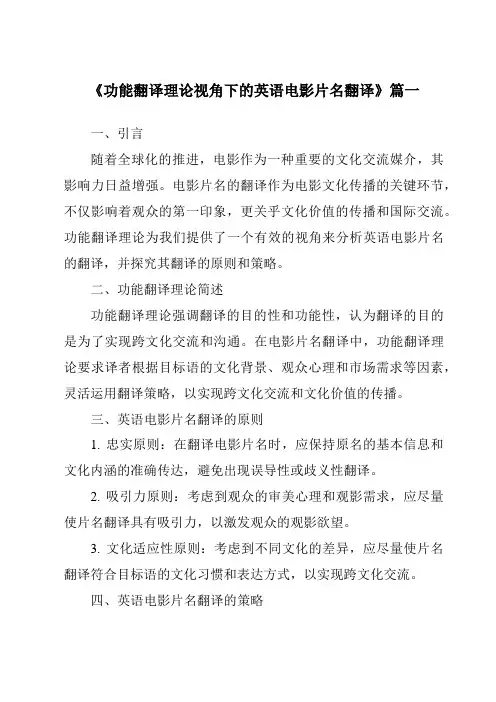
《功能翻译理论视角下的英语电影片名翻译》篇一一、引言随着全球化的推进,电影作为一种重要的文化交流媒介,其影响力日益增强。
电影片名的翻译作为电影文化传播的关键环节,不仅影响着观众的第一印象,更关乎文化价值的传播和国际交流。
功能翻译理论为我们提供了一个有效的视角来分析英语电影片名的翻译,并探究其翻译的原则和策略。
二、功能翻译理论简述功能翻译理论强调翻译的目的性和功能性,认为翻译的目的是为了实现跨文化交流和沟通。
在电影片名翻译中,功能翻译理论要求译者根据目标语的文化背景、观众心理和市场需求等因素,灵活运用翻译策略,以实现跨文化交流和文化价值的传播。
三、英语电影片名翻译的原则1. 忠实原则:在翻译电影片名时,应保持原名的基本信息和文化内涵的准确传达,避免出现误导性或歧义性翻译。
2. 吸引力原则:考虑到观众的审美心理和观影需求,应尽量使片名翻译具有吸引力,以激发观众的观影欲望。
3. 文化适应性原则:考虑到不同文化的差异,应尽量使片名翻译符合目标语的文化习惯和表达方式,以实现跨文化交流。
四、英语电影片名翻译的策略1. 直译法:对于那些具有明确概念和普遍意义的片名,可以采用直译法进行翻译,以保持原名的基本信息和文化内涵。
2. 意译法:对于那些抽象或富有隐喻的片名,可以采用意译法进行翻译,通过解释和阐释来传达原名的含义。
3. 创新法:在保持原名基本含义的基础上,可以根据目标语的文化背景和市场需求进行创新性的翻译,以使片名更具吸引力和独特性。
五、案例分析以《Titanic》为例,其中文译名为《泰坦尼克号》。
在这个例子中,直译了原片名的基本信息,同时保留了其文化内涵。
再如《The Shawshank Redemption》,其译名《肖申克的救赎》通过意译法传达了原片名的含义,并具有了更强的文化适应性。
这些成功的翻译案例都体现了功能翻译理论在英语电影片名翻译中的应用。
六、结论英语电影片名的翻译是一项复杂而重要的任务。
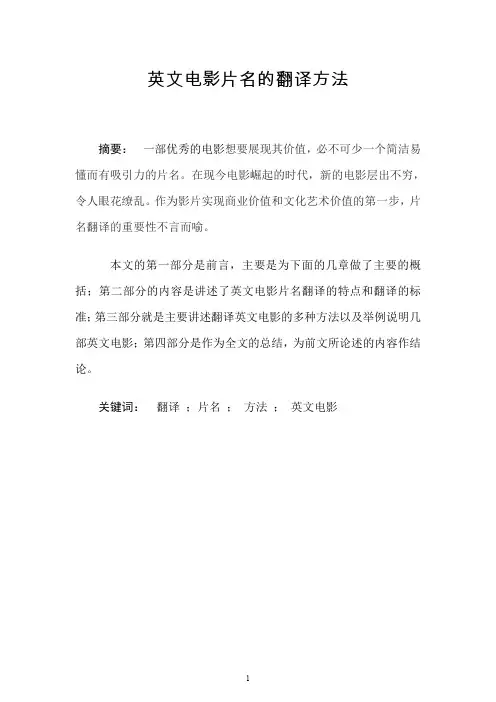
英文电影片名的翻译方法摘要:一部优秀的电影想要展现其价值,必不可少一个简洁易懂而有吸引力的片名。
在现今电影崛起的时代,新的电影层出不穷,令人眼花缭乱。
作为影片实现商业价值和文化艺术价值的第一步,片名翻译的重要性不言而喻。
本文的第一部分是前言,主要是为下面的几章做了主要的概括;第二部分的内容是讲述了英文电影片名翻译的特点和翻译的标准;第三部分就是主要讲述翻译英文电影的多种方法以及举例说明几部英文电影;第四部分是作为全文的总结,为前文所论述的内容作结论。
关键词:翻译;片名;方法;英文电影目录1.前言 (4)2. 英文电影片名翻译的特点与标准 (4)2.1 电影片名的特点 (4)2.1.1信息传递性 (4)2.1.2 文化特殊性 (4)2.1.3 艺术审美性 (4)2.2 翻译的标准 (5)3.英文电影片名的翻译方法 (5)3.1 直译 (5)3.2 意译 (5)3.3 音译 (6)3.4结合法 (6)3.4.1直译加意译 (6)3.4.2 音译加意译 (6)3.5 言简意赅法 (7)3.6 归化法 (7)4.结论 (7)参考文献 (7)致谢 (8)1.前言如今电影成为新时代的大众媒体,由多种艺术传播组合。
在信息化的时代,它不但能传播信息,并且可以在精神上给予人们灵魂的安抚和满足视觉的冲击。
电影既是一种让人通俗易懂的大众的媒体,又是一种特殊的艺术形式。
因此, 电影片名比较更为重要。
影视名的翻译尤其重要。
要把一部英文电影翻译到雅俗共赏、老少皆宜,首先要了解其翻译的特点和翻译的标准,以此为基准,再去熟悉翻译英文电影的方法,然后就可以尝试去翻译。
尽可能翻译出多几个,选择最适合的、最符合电影内容的就成了。
2. 英文电影片名翻译的特点与标准2.1电影片名的特点电影片名是由全影片的主题内容浓缩而成的,而且基本上电影片名都是第一时间展现给观众的,就是为了用片名来吸引观众,因此,对影片起到了做广告推广的作用。
2.1.1.信息传递性信息传递性是英文电影片名翻译最重要的特点。
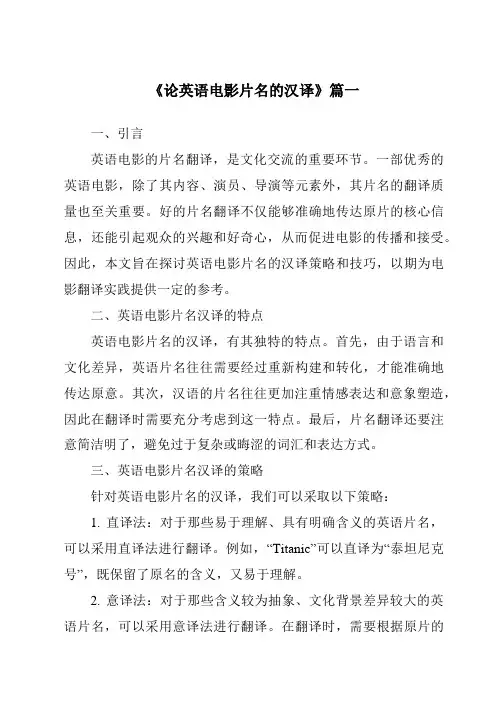
《论英语电影片名的汉译》篇一一、引言英语电影的片名翻译,是文化交流的重要环节。
一部优秀的英语电影,除了其内容、演员、导演等元素外,其片名的翻译质量也至关重要。
好的片名翻译不仅能够准确地传达原片的核心信息,还能引起观众的兴趣和好奇心,从而促进电影的传播和接受。
因此,本文旨在探讨英语电影片名的汉译策略和技巧,以期为电影翻译实践提供一定的参考。
二、英语电影片名汉译的特点英语电影片名的汉译,有其独特的特点。
首先,由于语言和文化差异,英语片名往往需要经过重新构建和转化,才能准确地传达原意。
其次,汉语的片名往往更加注重情感表达和意象塑造,因此在翻译时需要充分考虑到这一特点。
最后,片名翻译还要注意简洁明了,避免过于复杂或晦涩的词汇和表达方式。
三、英语电影片名汉译的策略针对英语电影片名的汉译,我们可以采取以下策略:1. 直译法:对于那些易于理解、具有明确含义的英语片名,可以采用直译法进行翻译。
例如,“Titanic”可以直译为“泰坦尼克号”,既保留了原名的含义,又易于理解。
2. 意译法:对于那些含义较为抽象、文化背景差异较大的英语片名,可以采用意译法进行翻译。
在翻译时,需要根据原片的主题和情感进行理解和表达,以传达出更加贴切的含义。
例如,“Forrest Gump”可以意译为“阿甘正传”,准确地传达了原片的主题和情感。
3. 创造性翻译法:对于那些在中文中没有直接对应的词汇或表达方式的英语片名,可以采用创造性翻译法进行翻译。
在翻译时,可以根据中文的表达习惯和文化背景进行创新性的表达,以使中文观众更好地理解和接受。
例如,“The Shawshank Redemption”可以创造性地翻译为“绿里奇迹”,既保留了原名的意象,又符合中文的表达习惯。
四、英语电影片名汉译的技巧除了了上述策略外,英语电影片名汉译还需要注意以下技巧:1. 注重文化差异:在翻译过程中,要充分考虑到中西方文化的差异,避免出现文化冲突或误解。
例如,某些在西方文化中具有特殊意义的词汇或表达方式,在中文中可能没有相应的含义或表达方式。
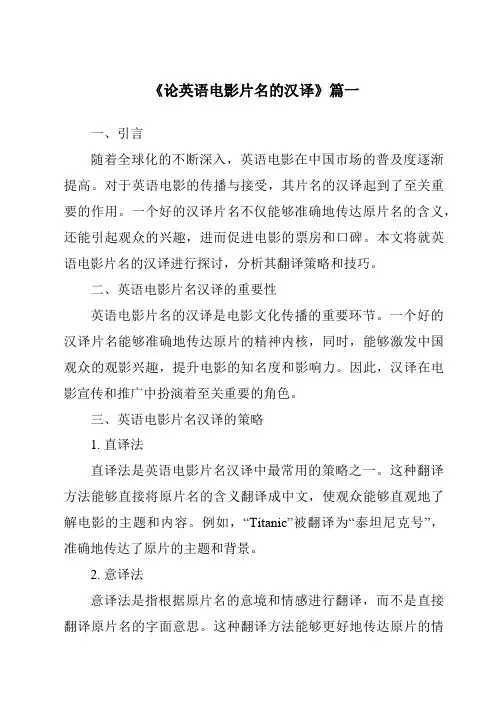
《论英语电影片名的汉译》篇一一、引言随着全球化的不断深入,英语电影在中国市场的普及度逐渐提高。
对于英语电影的传播与接受,其片名的汉译起到了至关重要的作用。
一个好的汉译片名不仅能够准确地传达原片名的含义,还能引起观众的兴趣,进而促进电影的票房和口碑。
本文将就英语电影片名的汉译进行探讨,分析其翻译策略和技巧。
二、英语电影片名汉译的重要性英语电影片名的汉译是电影文化传播的重要环节。
一个好的汉译片名能够准确地传达原片的精神内核,同时,能够激发中国观众的观影兴趣,提升电影的知名度和影响力。
因此,汉译在电影宣传和推广中扮演着至关重要的角色。
三、英语电影片名汉译的策略1. 直译法直译法是英语电影片名汉译中最常用的策略之一。
这种翻译方法能够直接将原片名的含义翻译成中文,使观众能够直观地了解电影的主题和内容。
例如,“Titanic”被翻译为“泰坦尼克号”,准确地传达了原片的主题和背景。
2. 意译法意译法是指根据原片名的意境和情感进行翻译,而不是直接翻译原片名的字面意思。
这种翻译方法能够更好地传达原片的情感和氛围,使观众能够更好地理解电影的主题和情感。
例如,“The Shawshank Redemption”被翻译为“肖申克的救赎”,传达了电影的救赎主题和情感。
3. 创新法创新法是指在翻译过程中加入创新元素,使汉译片名更具吸引力和独特性。
这种翻译方法能够更好地吸引观众的注意力,提升电影的知名度。
例如,“The Matrix”被翻译为“黑客帝国”,巧妙地结合了电影的科技元素和主题。
四、英语电影片名汉译的技巧1. 简洁明了汉译片名应该简洁明了,避免使用过于复杂的词汇和句式。
一个好的汉译片名应该能够迅速地传达原片的信息和情感,使观众能够一目了然。
2. 考虑文化差异在翻译过程中,应该充分考虑文化差异,避免出现文化冲突或误解。
例如,某些英文词汇在中文中可能有不同的含义或情感色彩,需要进行适当的调整或解释。
3. 注重语言美感汉译片名应该注重语言美感,使观众在欣赏电影的同时,也能够感受到语言的魅力。
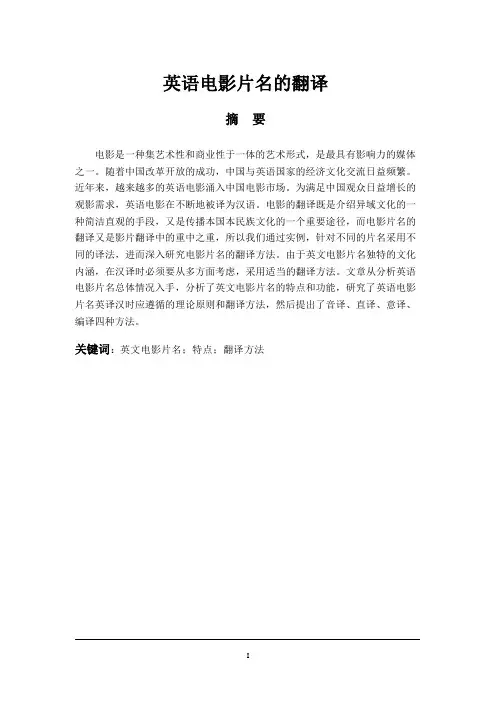
英语电影片名的翻译摘要电影是一种集艺术性和商业性于一体的艺术形式,是最具有影响力的媒体之一。
随着中国改革开放的成功,中国与英语国家的经济文化交流日益频繁。
近年来,越来越多的英语电影涌入中国电影市场。
为满足中国观众日益增长的观影需求,英语电影在不断地被译为汉语。
电影的翻译既是介绍异域文化的一种简洁直观的手段,又是传播本国本民族文化的一个重要途径,而电影片名的翻译又是影片翻译中的重中之重,所以我们通过实例,针对不同的片名采用不同的译法,进而深入研究电影片名的翻译方法。
由于英文电影片名独特的文化内涵,在汉译时必须要从多方面考虑,采用适当的翻译方法。
文章从分析英语电影片名总体情况入手,分析了英文电影片名的特点和功能,研究了英语电影片名英译汉时应遵循的理论原则和翻译方法,然后提出了音译、直译、意译、编译四种方法。
关键词:英文电影片名;特点;翻译方法IAbstractThe movie, a popular art with both artistic and commercial values, is one of the most influential mass media nowadays. With the success of China’s Reform and Opening up Policy and the strengthened economic and cultural communication between China and English-speaking countries, recent years we have seen a large flow of English movies into Chinese movie market. English movies are being continuously trans lated to meet Chinese audience’s growing needs. The translation of movies is not only a simple and direct way to introduce the exotic culture, but also an important channel to transfer our own culture. While the translation of the title of a movie is the top priority in translation movies, therefore, we study the way that the translation of movies deeply, using different ways to translate movies. As the titles of the English movies always carry the special cultural senses, when they translated into the Chinese, many factors should be considered and different methods of translation should be taken accordingly. The paper explores the general analysis of English movie titles, discusses the features and the function of the movie titles, and puts forward the relevant theories and methods, then gives the four translation methods: transliteration, literal translation, free translation and adapted translation.Key words: English movie title; feature; translation methodsIIContents Abstract (II)1 Introduction (1)2 A General Review of English Movie Title s (2)2.1 Categories of English Movies (2)2.1.1 Adventure Movies (2)2.1.2 Fantasy Movies (2)2.1.3 Comedy Movies (3)2.1.4 Lyric Movies (3)2.2 Features of English Movie Titles (3)2.2.1 Linguistic Features (3)2.2.2 Aesthetic Features (4)2.2.3 Cultural Features (4)2.2.4 Commercial Features (4)2.3 Functions of English Movie Titles (5)2.3.1 Informative Function (5)2.3.2 Aesthetic Function (5)2.3.3 Commercial Function (6)3 Methods of English Movie Title Translation (7)3.1 Principles of English Movie Title Translation (7)3.2 Methods of English Movie Title Translation (8)3.2.1 Transliteration (8)3.2.2 Literal Translation (9)3.2.3 Free Translation (9)3.2.4 Adapted translation (11)Conclusion (13)Bibliography (15)Acknowledgments (16)III1 IntroductionAs an audiovisual art, a product of a particular culture, movie is one of the most influential mass media reflecting people’s life. Although movie was born in the west, it is gaining prosperous popularity and has now become a global art. During the past decades since 1978 when China began to conduct its Reform and Opening-up Policy to the outside world, communication between China and the rest of the world, has been becoming increasingly frequent, resulting in the plunging of many foreign movies into China’s movie market. Since very few people can understand original English movies, all the original works have to be translated to reach the vast Chinese audience. Translating foreign audiovisual art works has become a significant activity in promoting cultural exchanges. However, movie translation is far from being explored. It is true to movie title translation in particular. The movie title, being short in form but rich in meaning, has its own linguistic, aesthetic and cultural features, which deserve careful investigation and consideration from the translator. Movie’s titles translation is the translation across cultural boundaries. A good translation of the movie title would unquestionably contribute a lot to the charm and success of the movie. On the contrary, a poor translation may not only fail to attract audience or even mislead the audience, but degrades the value and beauty of the original movie on the whole. Thus the translation of movie titles is an interesting, meaningful and demanding activity. A properly translated movie title should be concise, condensed and compact, which can grip the attention of the audience at their first sight and stimulate their association with the plot, reveal the theme or offer some clue. In this paper, we will introduce the categories of English movies, the general features, and functions of English movie titles, then set out four methods of translation, and a set of principles followed by the translation, then sum up movie title’s t ranslation should be combined with the translation practice, and continually improve in the practice.12 A General Review of English Movie TitlesIt is not difficult to see that movie, as a special art form, is different from other forms such as books or magazines, which could be laid on bookshelves for readers to appreciate first and decide whether to buy or not later. Movie differentiates itself from books, magazine and TV series in that it is able to achieve the effect of aesthetic, artistic and sensual pleasures at a very fast speed. Particularly in this hustle and bustle world, movie title is destined to be very attractive in the first place, so as to arouse people’s desire to watch before they walk into the cinema, and achieve its commercial goal, that is more box office as well. Whether the movie is attracting or not, the name is one important deciding factor, for it is often the first that comes into the potential viewer’s attention. If the title is eye-catching and curiosity-stimulating, the movie is half successful. As has been stated above, a good translation of movie titles may add charm to the movie and contribute a lot to the box-office value. Before we come to the core of the thesis, it is quite necessary to make a general analysis of English movie titles in order that it will provide a better understanding of the research subject.2.1 Categories of English MoviesAccording to He Ying, movies usually fall into three categories based on different contents: documentary movies, science and educational movies, and feature movies. Feature movies are most popular in Chinese movie market, they not only cater for people of all walks of life, but also convey the most cultural information, hence the present paper focuses specially on the Chinese translation of English feature films, which are further divided into four sub-categories, namely, adventure movies, fantasy movies, comedy movies and lyric movies.2.1.1 Adventure MoviesAdventure movies include action movies, horror movies, western movies,disaster movies, spy movies and crime movies. Titles of this kind of movies normally feature emotion-stirring effect. Examples are The Godfather《教父》,Once Upon A Time in the West《西部往事》, Rebecca《蝴蝶梦》.2.1.2 Fantasy MoviesFantasy movies are usually scientific, visionary and imaginative, with science fiction2movie as the main component. Titles of this kind aim to reveal new and strange things to the audience. A host of movies belong to this group, such as, Star War《星球大战》, Alien《异形》, Jurassic Park《侏罗纪公园》.2.1.3 Comedy MoviesComedy movies are designed to arouse laughter from the audience. Comedies are light-hearted dramas, crafted to amuse, entertain, and provoke enjoyment. Being rich in humorous flavor is the feature of titles of this type of movies. Movies such as Hot Shots! 《反斗神鹰》, It's a Mad, Mad, Mad, Mad World《疯狂世界》belong to this category.2.1.4 Lyric MoviesA large number of movies can be categorized into this type, including love story movies, family movies, drama movies and musical/dance movies. Movie titles of this kind are plain in wording but rich in romantic lyric and emotional flavor. Examples are Gone with the Wind《乱世佳人》, Golden Pond《金色池塘》, Love Story《爱情故事》, etc.2.2 Features of English Movie TitlesAlthough movies, as a kind of literary form, have something in common with other literary forms, they also possess some unique features, which make them different from others. The same is true of the case of movies titles. In the following part the overall features of English movies titles will be expounded from the linguistic, aesthetic, cultural and commercial perspectives.2.2.1 Linguistic FeaturesGenerally speaking, although English movie titles are very short, concise and compact with regard to the structure, yet rich in meaning. Lots of movie titles only contain one word, which may be the name of the hero or heroine, the place, or the time where or when the story happens or the theme of the whole story. For instance, Ali《拳王阿里》, Jaw《大白鲨》, Crash《冲撞》and Munich《慕尼黑》. Sometimes, they adopt various kinds of phrases as titles, namely, noun phrases, verb phrases and prepositional phrases, which are exemplified in the following titles: The Silence of the Lamb《沉默的羔羊》,consisting of a modifier and the word it modifies; Dance3With Wolves《与狼共舞》,using the structure of a verb-object phrase; On Golden Pond《金色池塘》,employing the prepositional phrase. In addition, some movies employ highly concise sentences as the titles. For instance,It’s a Wonderful Life《美好生活》,The Superman Returns《超人归来》.2.2.2 Aesthetic FeaturesAs mentioned before, movie is a typical form of the modern art, which has its own aesthetic values and features. Being the part which first greets the audience’s eyes, the title of a movie can well reflect such aesthetic features. Generally speaking, the aesthetic characteristics of movie titles are closely related to the application of rhetorical devices, such as simile, metaphor, irony, personification, alliteration, and so on. For example: The Elephant Man《象人》(metaphor), Crystal Heart《心如水晶》(simile), True Lies《真实的谎言》(oxymoron), What Price Glory《光荣何价》(rhetoric question), The Science of the Lambs《沉默的羔羊》(allusion).2.2.3 Cultural FeaturesMovie titles are closely related to various aspects of societies, such as religion, history, philosophy and so on. More often than not, cultural features are closely related to the quotation of idioms and allusions, which convey rich cultural meanings.For example, movies such as Seven《七宗罪》, Original Sin《原罪》are enveloped in strong Western color, and clearly show the great influence upon English movie titles exerted by western religious culture. A movie is a mirror and conveyer of a specific culture as the social context, cultural phenomena and ideology are shown and implied in it. This feature of movies can be reflected at the level of movie titles, which are inevitably branded by the typical national characteristics and cultural values. Chinese people can gradually get familiar with western cultures by getting in touch with English movies and fully understanding the titles with cultural-loaded words.2.2.4 Commercial FeaturesAs a popular artistic form, movies are products of commercialization. To some extent, it is justified in saying that a movie will be meaningless if it cannot attract the public attention and bring large profit. Therefore, film titles should always be4eye-catching and be tinged with commercial color. In a sense, such characteristic can help to boom the movie industry. However, this does not mean that one can merely pursue large commercial profit by providing some queer titles with no regard to the connotation of the original.2.3 Functions of English Movie TitlesWhat on earth is the function of a movie title? Simply speaking, its primary function is to identify the film. In other words, a film title is a guide and interpreter of a film, which is firstly able to promote sal es of the film and cause people’s interest, viewers’ discussion, researchers’analysis etc. Therefore, a good title can be regarded as a kind of catalyst for the audience so that they have already had an emotional resonance with the film before the actual appreciation of it. Generally, movie titles have three basic functions: the informative function, the aesthetic function and the commercial function.2.3.1 Informative FunctionThe informative function is the basic function that any movie titles should possess. As the word “informative”reveals, this function provides basic or relevant information to the target reader. The core of informative function is the facts of the topic, the reality outside the language and the idea. As for a film title, it is supposed to give hint to the audience about what is going on in the story, thus help the audience decide whether they are interested in the movie or not.2.3.2 Aesthetic FunctionThis is the language designed to please the senses, firstly through its actual or imagined sound and secondly through its figures of speech. The rhythm, balance and contrasts of sentences, clauses and words also play their part. An excellent movie title can also perform aesthetic function in terms of providing the audience aesthetic enjoyment through colorful words with sound effects and the application of rhetorical devices. Movie titles with aesthetic function please the feelings of audiences through their unevenness in intonation, smoothness in sound and vividness in image presentation.52.3.3 Commercial FunctionNowadays, it is very common that a movie costs hundreds of millions of dollars, especially the hot hit made by Hollywood. The commercial function proposed in this thesis is, to some extent, similar to the vocative function, the core of which is the readership, the addressee.Taking this explanation as reference, it can be concluded that a good movie title can also “call upon” the audience to see the movie, or to react in the way intended by the producer-buying tickets so that great box office will be generated.63 Methods of English Movie Title TranslationThe title is the head of the movie, and it serves at least three functions, as afore-stated, that is the informative function, the aesthetic function and the commercial function. A movie title usually embodies more than one function; nonetheless it inevitably will put emphasis on one of them. It is also the case with translation methods. Various translation methods or techniques exist and can be employed by the translator. Yet, none of them can solve all of the problems, so in movie titles translation, there must be one or more methods that are favored and are relied on by a translator. This chapter is devoted to the demonstration of the main techniques and methods enjoying the most popularity in this field, and when necessary, examples are cited to further elaborate the demonstration.3.1 Principles of English Movie Title TranslationThe so-called principles and criteria of translation are actually the two aspects of the same thing. The former lays emphasis on the translator, who should follow these principles while translating; while the latter on the reader or critic, who may use the criteria to evaluate translation works. Whenever principles or criteria of translation are under discussion in China, Yan Fu’s “three-character guide”, which was first proposed in 1898, would be mentioned, namely, the principle of “信,达,雅” (faithfulness, expressiveness and elegance). In the past decades, Mr. Yan’s principle of translation has been generally regarded as a yardstick to measure the professional level of translation and a goal for translators to strive after. However, some scholars maintain the original three characters, and in the meantime add some new concepts to the character “elegance”. Despite the variety of opinions, two criteria are unanimously accepted, namely, the criterion of faithfulness/accuracy and that of smoothness, we may also take these two criteria as the principles of translation in general.A movie title is the foremost window through which the audience may get a rough idea of the content of the movie at first sight. Therefore, how to translate English movie titles successfully into Chinese has become an exceedingly important issue for the introduction of English movies to China. However, adopting what translation methods for translating English movie titles first needs a set of scientific principles, under the guide of which the translated film titles would be attractive,7easy to be accepted and can fulfill the functions the original ones have. At the same time, English movie title translation is a cross-cultural communication process. In order to achieve the expected effect, in the translation of English movie titles, the translators need to pay attention to the above principles.3.2 Methods of English Movie Title TranslationAs we all know, there exist many translation methods and no one single method can solve all problems of translation. This is especially true with English movie title translation. Techniques and methods are applied in English movie title translation. There are four types of translation strategies altogether in the present thesis, namely, transliteration, literal translation, free translation and adapted translation.3.2.1 TransliterationTransliteration means to write words or letters in or as the letters of a different alphabet and to preserve the sounds of the original to the largest extent, is an indispensable translation method when there is no semantic equivalence between two texts. In movie titles translation, it is characterized by phonetic correspondence, that is, to describe the English syllables through the corresponding Chinese characters carrying similar sounds. Transliteration is usually used in the translation of proper names, names of persons and places in movie titles. The translator needs to find the corresponding Chinese characters carrying similar pronunciation and acceptable to Chinese audience. Although this approach is not widely used in English movie title translation, it is indispensable. A few examples are given below: Casablanca《卡萨布兰卡》, Chicago《芝加哥》. Many movies adapted from famous literary works just follow the transliterated names of the original, such as Romeo and Juliet is translated into《罗密欧与朱丽叶》, Sister Carrie into《嘉莉妹妹》and Jane Eyre《简爱》. It is also true with the name of celebrities, historic figures, well-known places, historic events like Gandhi《甘地》, Harry Potter《哈利波特》.Just as every coin has two sides, transliteration has both advantages and disadvantages. On the one hand, it keeps the rhythm and forms of the original title and attracts the audience’s attention by its strong foreign flavor. The foreignness may arouse the audience’s curiosity to explore what is exotic and unknown to them. What’s more, as the movie title is already of cognitive value and significance to the audience, the audience will feel easier to get access to the movie. On the other hand,transliteration is to write the foreign words in Chinese characters carrying similar sounds, which may make no much sense to the audience since the title gives little information or hint about the movie to the audience but an unfamiliar name.3.2.2 Literal TranslationLiteral translation is applied frequently in English movie title translation. It can reproduce both form and content of the original in most cases. This method proves very simple, feasible and effective when the title reflects almost exactly the original content of the film. Such titles can be directly translated into Chinese without much second thought. Some examples are listed below: Around the World in 80 Days 《环游地球八十天》, Schindler’s List《辛德勒的名单》, Pearl Harbor《珍珠港》, Lion King《狮子王》, The Princess Diaries《公主日记》, Roman Holiday《罗马假日》.Sometimes the adjustments of word order prove necessary and deserve due attention when the technique of literal translation is used. That is when the literal approach is applied in titles translation. The translator needs to pay attention to the wording of the translated version, to be specific, to make the version concise, compact, vivid, appropriate and comprehensible to the audience. For instance,“云中漫步”is a better version than “漫步在云端” for the romance film A Walk in the Clouds. Other examples involving change of word order are as follows: Man in Black《黑衣人》, A Cry in the Dark《在黑暗中哭泣》and so on.The above demonstration is all about advantages and the applicability of the literal approach to English movie titles translation. It retains a unity of the form and information between the translated version and the original. It also keeps the exotic flavor of the source text and generally well serves the vocative function of the title to attract eyeballs. However, it can also cause problems. Sometimes literal translation may confuse the reader because there are differences between languages. And incompatibility between the form of the translated version and the original content may appear, especially when cultural elements are involved. To solve the problem, other methods or techniques need to be employed so that connotations of the original title can be preserved and the basic functions of the film title be fulfilled completely.3.2.3 Free TranslationIn any translation, translators have to remind themselves of not expecting to findequivalent expressions in the target language all the time. In this situation, they may often need to adopt free translation, which is an alternative approach that is used mainly to convey the meaning and the spirit of the original title without sticking to the form mechanically.Some movie titles convey strong cultural flavor, like the use of cultural-loaded words, phrases and id ioms. In such occasions it’s difficult to reserve the original form and meanwhile make the target audiences understand the inner meaning of the title. Free translation is applicable in these cases. For example: One Flew Over the Cuckoo’s Nest《飞越疯人院》, Seven《七宗罪》, etc.Free translation need not pay attention to the form of the original, including the construction of the original sentences, meaning of the original works, and metaphor in the original and so on. By free translation, people are able to render the brief message of the original title in a more free and flexible way. But free translation does not mean to delete or add content to the original and translators must consider the original carefully, know its stress, translate it naturally, and express the meaning of the original.A typical example is the translation of Waterloo Bridge《魂断蓝桥》,which tells a tragic love story. The word “bridge” is kept and translated literally, for it plays a considerably important part in the movie where the story takes place and the heroine eventually commits suicide. Taking the cultural connotation into consideration, the translator skillfully resorts to the Chinese folktale of Blue Bridge“蓝桥相会”, a Chinese allusion going like this: a young man named Wei Sheng fell in love with a beautiful girl and they pledged to get married, but the girl’s parents didn’t agree, so they made an appointment to meet at the “blue bridge” outside the town to run away. It rained heavily that night. Wei Sheng waited for the girl’s coming who had been detained by her parents. Wei Sheng did not want to betray their oath and kept waiting, as a result, he was drowned by the flood; when the girl escaped from home and arrived at the bridge, she felt so sad when she saw Wei Sheng’s dead body; without hesitation, she jumped into the river embracing Wei Sheng. After that, Chinese people used the “blue bridge” to stand for the lovers’ meeting place.The translation“魂断蓝桥”implies an emotion of departure, which may easily arouse resonance among the Chinese audience. Considering the mood of the story, the two Chinese character“魂断”are added to conform to the tragic atmosphere of the film, which can easily kindle the audience’s curiosity about a heart-stirring lovestory hidden between the lines. In addition, the selection of the Chinese four-character structure well suits the taste of the Chinese audience and is in accordance with the Chinese aesthetic standard, thus having a great attraction to the audience. If it is literally translated as “滑铁卢桥”,the Chinese audience might easily associate this film with the defeat of Napoleon in the Battle of Waterloo,and take it as a war movie. However, this is a romantic and sad love story and Waterloo Bridge in the movie merely serves as a background scene. For these reasons, compared with the slavishly translated version“滑铁卢桥”,which sounds lifeless and tasteless and which may cause the Chinese audience to associate it with a historical movie about Napoleon, the version“魂断蓝桥”surpasses in successfully achie ving the informative, aesthetic as well as the appellative functions.More successful cases could be found in movie title translation practice, such as Speed《生死时速》, County Bridge《廊桥遗梦》, Ghost《人鬼情未了》, Forrest Gump《阿甘正传》, The Devil Wears Prada《时尚女魔头》and so on.However, translators should distinguish free translation from random translation. A good free translation is not the unrestrained imagination of the translator, but should be created by a thorough understanding of the movie content, theme and spirit, so as to retain and better express the original meanings and artistic features of the movie title.3.2.4 Adapted translationAdapted translation is the last resort in translating English movie titles. It occurs sometimes to the translator that neither literal nor liberal translation works in some cases. Even if handled by the virtue of the two methods, some renderings still become obscure and hard to understand,or tend to be pedestrian and flat, or ambiguous and misleading. Faced with such dilemma, the translator has to develop his initiative and creativity to crack the hard nut. The choice would be adapted translation. Adapted translation is to shake off the original title and makes a fresh one based on the content of th e movie. This approach lies in “betr aying” the original title so as to be loyal to the latent meaning, the theme and the style of the movie. To a large extent, adapted translation is a process of generalization of the content of the movie. Therefore, the translator must first understand the content and theme of the original movie thoroughly, and then correctly and creatively reproduce a title.In the practice of English movie title translation, many successful creative andappropriate Chi nese versions meet the audience’s eyes, in which the diction is carefully weighted, the thematic meaning deeply explored, the artistic effect vividly reproduced and great interest and desire from the audience conjured up accordingly. The American science fiction film The Day After Tomorrow tells a story of the relation between human beings and the natural environment. Global warming melts the polar ice caps, which makes the oceans rise and disrupts the Gulf Stream. A climate shift occurs, sending the Earth into an ice age. Millions die and the world is changed forever, but the planet has “cleansed” itself. The translators give the version 《后天》and《明天过后》respectively, both of which are literal translations. The version《末日浩劫》is an example of adapted translation. For such a grand scene and a shocking and alarming movie, the latter version is apparently preferable than the slavishly translated versions. In《后天》and《明天过后》,the real meaning of the title has gone, the panic atmosphere and alarm bell effect have been ignored and the artistic appeal has been reduced to a large extent. Here are more examples of successful adapted translation: Volcano《地火危城》You Can’t Take It with You《浮生如梦》, Sideways《杯酒人生》.In summary, taking all translation methods into consideration, which one gets the upper hand and thus is preferable in English movie titles translation? As demonstrated above that each one has two sides. It is unrealistic to advocate literal translation or liberal translation or even adaptation as the sole recommended method of titles translation. It can be found from the previous analysis and examples that there is no definite contradiction among the methods. For many versions, it is hard to tell exactly what specific method is employed.Actually, all the methods are indispensable and supplementary to each other. No single method can always solve all the problems in titles translation. Whenever one method does not work well for linguistic, customary, and cultural or other factors, naturally the translator should turn to the supplementary methods for help so that he/she can accomplish his/her task. The most important requirement for English movie titles translation is that the translator must have a comprehensive understanding of the whole film including plot, theme, and cultural background and so on. To read a title needs only a few seconds, whereas to understand the entire film takes at least tens of minutes. Again it proves that movie titles translation is not an easy task. In addition, the translator should have a deep understanding of the essence of each method and make the best use of them in a flexible and appropriate way.。
《从目的论的角度谈英文电影片名的翻译》篇一一、引言随着全球化的不断深入,电影作为一种文化交流的媒介,其影响力日益增强。
在跨文化交流的过程中,英文电影片名的翻译变得至关重要。
好的翻译不仅能够准确地传达电影的核心信息,还能够吸引观众的兴趣,进一步扩大电影的受众群体。
本文将从目的论的角度出发,探讨英文电影片名的翻译方法及原则。
二、目的论概述目的论,又称功能目的论,是翻译研究中的一个重要理论。
这一理论强调翻译行为应遵循“目的性原则”,即翻译活动的目的是为了达到一定的效果和预期功能。
在电影片名的翻译中,这一原则指导我们在理解和表达上达到最理想的翻译效果。
三、电影片名翻译的目的电影片名的翻译目的是为了向观众传达电影的核心信息,激发观众的兴趣和好奇心,进而吸引他们观看电影。
因此,在翻译过程中,应遵循以下原则:1. 传达电影的核心价值与情感基调2. 准确传达电影的类型与风格3. 便于观众记忆和传播四、翻译方法与技巧(一)直译法直译法是一种常见的翻译方法,即在保证原文语义不变的前提下,直接将英文片名翻译成中文。
这种方法适用于那些在两种语言中具有相同或相似文化内涵的片名。
例如,“Titanic”可以直译为“泰坦尼克号”,保留了原名的含义和情感色彩。
(二)意译法意译法是指根据电影的内容和主题,重新构思并翻译英文片名的方法。
这种方法适用于那些在两种语言中文化内涵差异较大的片名。
例如,“The Shawshank Redemption”可以意译为“绿里奇迹”,更好地传达了电影的主题和情感。
(三)创新法创新法是指在翻译过程中,根据中文的审美习惯和表达方式,对英文片名进行创新性的翻译。
这种方法能够更好地吸引观众的注意力,如“Gone with the Wind”被译为“乱世佳人”,使得片名更具艺术性和吸引力。
五、案例分析以电影《Interstellar》为例,其原意为“星际穿越”。
在翻译过程中,译者采用了直译法,将原片名直接翻译为中文“星际穿越”。
《英文电影片名的翻译策略与翻译方法研究》篇一一、引言电影作为文化传播的媒介,电影片名是其核心标识,具有重要的吸引观众、传播文化及构建影片品牌形象的功能。
对于中英两国之间日益密切的电影文化交流,英文电影片名的翻译显得尤为重要。
本文旨在探讨英文电影片名的翻译策略与翻译方法,以期为电影翻译实践提供理论支持。
二、英文电影片名的翻译策略1. 直译法直译法是英文电影片名翻译中最常用的策略之一。
其特点在于尊重原文内容,保留原文词汇所表达的完整含义,以便使观众准确理解电影的情节与主题。
但使用直译法时,需要关注不同文化背景下中英词语所可能产生不同情感效果与语言风格的差异。
2. 意译法相较于直译法,意译法更注重将原文所表达的含义以更符合中文表达习惯的方式呈现出来。
这种方法可以更准确地传达电影的内在含义和情感色彩,但需要注意避免过度翻译或遗漏关键信息。
3. 音译法音译法主要用于翻译一些具有特定文化内涵或难以用直译或意译表达的英文电影片名。
通过音译法,可以保留原片名的独特性,同时使中文观众更容易接受和记忆。
但需要注意的是,音译法需要确保翻译的准确性,避免产生歧义或误解。
三、英文电影片名的翻译方法1. 结合影片内容翻译在翻译英文电影片名时,要充分考虑影片的情节、主题及导演意图等,以确保翻译内容能够准确地传达影片的整体氛围。
在适当的情况下,还可以使用词语组合、成语典故等方式丰富译文内涵。
2. 关注目标受众文化背景在进行英文电影片名翻译时,应充分了解目标受众的文化背景、审美观念及语言习惯等因素,以选择合适的翻译策略与方法。
例如,对于喜欢轻松幽默的观众群体,可以采用幽默诙谐的翻译风格;而对于追求高雅艺术的观众群体,则应采用更加文艺的翻译方式。
3. 保持翻译一致性在多部电影的片名翻译中,应保持一定的翻译一致性,以避免观众产生混淆。
这需要在选择翻译策略与方法时,考虑到同一系列或同一导演的电影片名之间的相互关系与整体风格。
四、案例分析以《The Shawshank Redemption》为例,这部电影的中文译名为《肖申克的救赎》。
英文电影片名的汉译研究摘要在全球化的背景下,传统文化与现代文明的交融和相互影响,人们用电影陶醉他们自己。
越来越多的外国电影进入中国市场,这些电影被翻译成中国电影 ,后来已经成为老少皆宜、雅俗共赏的艺术形式,是最具影响力的媒体之一。
好的片名翻译既能实现电影的商业价值,又能实现其审美价值,使观众得到艺术的熏陶,美的享受以及高尚情操的陶冶。
片名翻译的成功与否直接关系到电影的传播及研究的深入程度。
英文电影片名要从交际功能,信息功能,表达功能及审美功能以后要从这几个方面深入研究。
[关键词] 重要性三种功能影响AbstractIn the background of globalization, traditional culture and modern civilization are affected influence with each other, people are addicted to them.a growing number of foreign films enter chinese market , these films have been translated Chinese movies , films have been now become a form of art, is one of the most influential media. The movie title, the film's brand names, directly play the role of "guides". Good title films become commercial value, it`s becomeming aesthetic value, The success of the title translation is related to the spread and depth of the film directly. Good title films are very important with spreading .it included exspression function ,informationfunction ,communication funtion ..[Key words] importance three functions affection目录一、前言 (1)二、电影对全球文化的影响 (2)(一)传统文化与现代文化的交融 (2)(二)英汉电影片名产生的双文化影响 (3)(三)中国文化对电影的影响 (4)三、中国文化对外国电影翻译的重要性 (6)(一)现阶段中国电影译名的特点以及重要性 (6)1.以国内传统的翻译标准为指导 (7)2、借用诗词成语对译名的重要性 (7)(二)中国电影译名的发展阶段及其特点 (8)四、英语电影片名的翻译功能技巧及未来发展 (10)(一)英语电影片名的翻译功能及未来的发展 (12)五、结论 (13)主要参考文献 (15)致谢·······················································································错误!未定义书签。
《论英语电影片名的汉译》篇一一、引言英语电影的汉译工作在传播和推广中起到了关键的作用。
作为翻译的重要环节,片名的翻译尤为重要,因为它们不仅影响观众对电影的第一印象,也是观众决定是否观看某部电影的参考依据。
本文旨在深入探讨英语电影片名的汉译方法和策略,以期提高翻译质量和准确性。
二、英语电影片名汉译的复杂性英语电影片名的汉译过程需要面对多方面的复杂性。
由于语言、文化差异以及社会背景的差异,如何准确地传达原片名的内涵、情感和主题成为了翻译的难点。
同时,在汉译过程中还需要考虑到观众的审美、习惯以及文化认同感。
因此,片名翻译既是一门技术,也是一门艺术。
三、英语电影片名汉译的方法与策略(一)直接翻译法直接翻译法是较为常见的一种翻译方法。
通过直接翻译英文片名,尽量保留原片名的表达方式和内容。
这种方法的优点是能够准确传达原片名的含义,但同时也需要考虑到中文表达习惯和审美。
(二)意译法意译法是根据电影的主题和内容,结合中文表达习惯进行翻译。
这种方法可以更好地传达电影的内涵和情感,但需要注意避免过度创新或偏离原意。
(三)创新翻译法在某些情况下,为了更好地吸引观众,可以采用创新翻译法。
这种方法在保留原片名核心内容的基础上,通过添加修辞手法、成语、典故等元素,使翻译更具吸引力和文化内涵。
四、英语电影片名汉译的注意事项(一)准确传达原意在翻译过程中,首先要确保准确传达原片名的含义。
这需要充分理解原片名的内涵和情感,以及电影的主题和内容。
(二)考虑文化差异由于中西方文化差异较大,在翻译过程中需要考虑到中文观众的审美和习惯。
例如,某些在西方文化中常见的元素在中文文化中可能并不常见,因此需要进行适当的调整和创新。
(三)简洁明了汉译的片名应该简洁明了,避免过于复杂的表达和冗长的句子。
这样更易于观众理解和记忆。
五、结论英语电影片名的汉译是一项复杂而重要的工作。
通过采用不同的翻译方法和策略,可以更好地传达原片名的内涵、情感和主题。
同时,还需要考虑到中文观众的审美和习惯,以及文化差异等因素。
《论英语电影片名的汉译》篇一一、引言英语电影的片名翻译,是文化交流的重要环节。
一部优秀的英语电影,除了其内容、演员、导演等元素外,其片名的翻译也至关重要。
它不仅关系到电影的宣传推广,也直接影响着观众的选择和观影体验。
因此,对英语电影片名的汉译进行深入研究,具有重要的现实意义。
二、英语电影片名汉译的特点1. 忠实原意:翻译英语电影片名时,首先要忠实于原片名的意义,保持原意的基本准确性。
2. 文化适应性:由于不同文化背景的差异,翻译时需考虑中文语境下的表达习惯和审美标准,使翻译后的片名更符合中文观众的审美需求。
3. 创新与吸引:在忠实原意和文化适应的基础上,翻译者还需通过创新手法,使片名更具吸引力,以激发观众的好奇心和观影欲望。
三、英语电影片名汉译的方法1. 直译法:对于一些含义明确、文化内涵较少的英语电影片名,可采用直译法进行翻译,如《泰坦尼克号》、《阿甘正传》等。
2. 意译法:对于一些含义抽象、文化内涵丰富的英语电影片名,可采用意译法进行翻译,通过解释原片名的含义,使中文观众更好地理解电影内容,如《疯狂的石头》、《霸王别姬》等。
3. 创新法:在保持原意的基础上,通过添加修辞手法、四字成语等方式,使片名更具创新性和吸引力,如《致命魔术》、《大话西游》等。
四、英语电影片名汉译的实例分析以《The Shawshank Redemption》为例,其汉译为《肖申克的救赎》。
此翻译既忠实于原意,又考虑了中文表达习惯,同时具有吸引力。
再如《Forrest Gump》,其汉译为《阿甘正传》,既保留了原片名的基本信息,又通过创新手法使片名更具记忆点。
五、结论英语电影片名的汉译是一项复杂而重要的工作。
翻译者需在忠实原意、文化适应和创新吸引之间找到平衡点。
通过直译、意译和创新法等多种翻译方法,将英语电影片名准确地传达给中文观众。
同时,翻译者还需不断学习和提高自己的语言功底和文化素养,以更好地完成英语电影片名的汉译工作。
《英语电影片名汉译研究》篇一一、引言随着全球化的推进,英语电影在中国市场的普及率越来越高,而电影片名的翻译作为电影宣传和推广的重要手段,其质量直接影响着观众的接受程度和电影的票房成绩。
因此,对英语电影片名汉译的研究具有重要的现实意义。
本文旨在探讨英语电影片名汉译的原则、方法和技巧,以期为电影片名的翻译提供有益的参考。
二、英语电影片名汉译的原则1. 准确性原则:翻译应准确传达原片名的含义,确保观众能够准确理解电影的内容。
2. 简洁性原则:翻译应简洁明了,避免冗长的词语和句子,以便观众快速记忆和传播。
3. 文化适应性原则:翻译应考虑中国观众的文化背景和审美习惯,使翻译后的片名更符合中国市场的需求。
三、英语电影片名汉译的方法1. 直译法:直接将英语片名翻译成中文,保留原片名的含义。
例如,“Titanic”译为“泰坦尼克号”,准确传达了原片名的含义。
2. 意译法:根据原片名的含义,采用意译的方式翻译成中文。
例如,“The Shawshank Redemption”译为“肖申克的救赎”,更好地表达了电影的主题和情感。
3. 创新翻译法:在保留原片名核心意义的基础上,采用创新的翻译方法,使翻译后的片名更具吸引力。
例如,“Forrest Gump”译为“阿甘正传”,通过添加“正传”二字,使片名更具故事性。
四、英语电影片名汉译的技巧1. 利用四字词语:四字词语在中文中具有简洁、明了的特点,在翻译英语电影片名时,可适当采用四字词语,使翻译后的片名更符合中文的表达习惯。
2. 添加文化元素:在翻译过程中,可适当添加中国文化元素,使翻译后的片名更具中国特色。
例如,可在片名中加入地名、人物名称等元素,以增强观众的认知度。
3. 考虑语境:翻译时应考虑原片名的语境和背景,确保翻译后的片名与原片名的含义相符合,避免产生歧义。
五、结论英语电影片名的汉译是一项具有挑战性的工作,需要遵循一定的原则、方法和技巧。
通过准确性、简洁性和文化适应性原则的指导,采用直译法、意译法和创新翻译法等方法,以及利用四字词语、添加文化元素和考虑语境等技巧,可以为英语电影片名的翻译提供有益的参考。
The Translation of English Film Titles
Chapter One Introduction
Clarify the research background and meaning, theoretical frame and organization structure of this thesis.
Chapter Two The analysis of English movie titles
I. Types of film
II. General features of English film titles
i. Language characteristic
ii. Artistry
iii.culturality (文化性)
ⅳ. Commercial
III. The principles of English film titles translation
i. Information value principle
ii. Aesthetic principles
iii. Goal orientation principle
ⅳ. Cultural value principle
Chapter Three The function and role of E nglish film titles
I. Correspond with the film and be easily understood
II. Concise and easy to be remembered
III. Attract audience and increase the box-office income
Chapter Four The translation methods and skills of English film titles
I. Translation methods of English film titles
i. Literal translation
ii. Free translation
II. Translation skills of English film titles
i. Combination of literal translation and free translation
ii. Compiling method
Chapter Five Conclusion
Summarize the whole passage, put forward some suggestions to the translation of film titles. Also points out the limitation of essay writing and bring up some suggestions in future research.
第一章绪论
阐明本文的研究背景、写作目的、理论框架和组织结构。
第二章英语电影片名的分析
对英语电影片名做了一个总体分析:介绍了电影的种类,分析了电影片名的基本特点和原则,为探讨其翻译方法奠定了基础。
2.1电影的种类
根据电影的不同内容和性质,我们大致可将其分为爱情片、战争片、伦理片、科幻片、悬疑片等。
2.2英语电影片名的基本特点
2.2.1语言特色
2.2.2艺术性
2.2.3文化性
2.2.4 商业性
2.3 英语电影片名翻译的原则
2.3.1信息价值原则
2.3.2美学欣赏原则
2.3.3 目标取向原则
2.3.4文化价值原则
第三章英语电影片名的功能及作用
本章具体探讨了电影片名所具有的三种基本功能,即1)切合原影片的内容、反映原影片的主题、突出原影片的风格;2)言简意赅、便于记忆;3)吸引观众、增加票房收入。
3.1切合影片,通俗易懂
3.2言简意赅,便于记忆
3.3吸引观众,增加票房收入
第四章英语电影片名翻译的方法及技巧
4.1英语电影片名的翻译方法
4.1.1直译
4.1.2意译
4.2英语电影片名的技巧
4.2.1直译意译结合
4.2.2编译法
第五章结论
结论部分,对全文进行了总结,对电影片名的翻译提出了一些建议,同时也指出了论文写作的局限性并对今后的研究提出了一些建议。